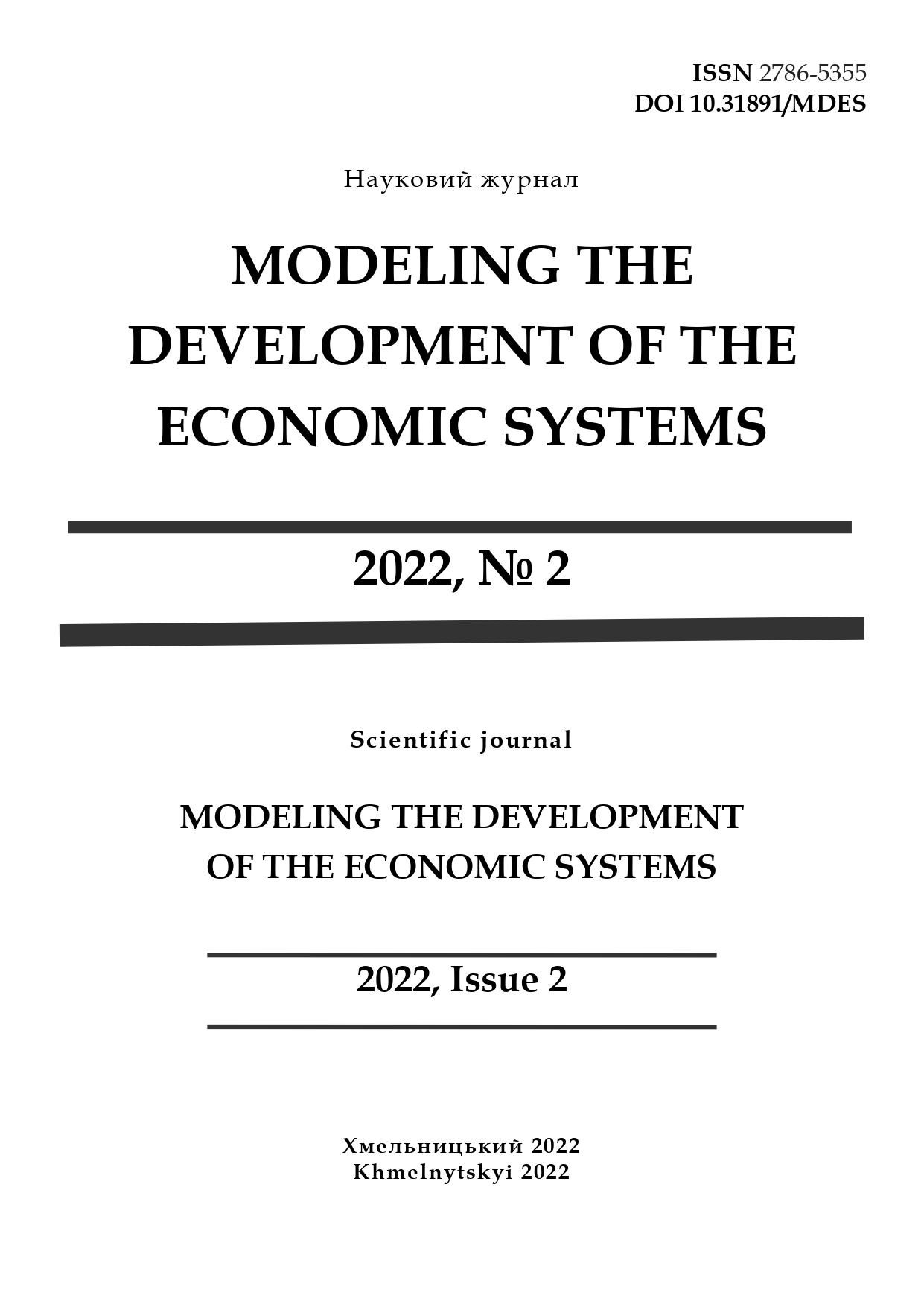DEVELOPMENT OF DEMOGRAPHIC POTENTIAL OF THE CARPATHIAN REGION OF UKRAINE IN THE VECTOR OF INTENSIVE YOUTH MIGRATION MOBILITY
DOI:
https://doi.org/10.31891/mdes/2022-4-3Keywords:
youth, Carpathian region, migration mobility, potential, natural losses, demographic sustainability, monitoringAbstract
The problem of intensification, uncontrolled spread of migration mobility of young people is widespread in many countries of the world but remains a challenge for Ukraine, where low economic growth is both the cause and consequence of significant migration of young people, which leads to a weakening of intellectual and personnel security and a decrease in the demographic potential of the country. mobility of young people. The method of studying the demographic potential of young people in the Carpathian region is to be forming an empirical guide based on an integrated assessment of demographic indicators. The integral index for the development of the demographic potential of young people is calculated by weighing group coefficients.
It is established that the regions of the Carpathian region of Ukraine have a moderate level of human potential among young people. Migration mobility of young people of the Carpathian region of Ukraine from 2010-to 2020 was sigmoidal and determined mainly by the socio-economic environment. It was found that the average annual increase in the level of migration mobility of young people in the Carpathian region of Ukraine was 1.8%. From 2010-to 2020 in the Carpathian region of Ukraine, the rate of development of the demographic potential of young people was 20% higher than in Ukraine as a whole. There is a downward trend, from 0.901 in 2010 to 0.883 in 2020 in the Carpathian region of Ukraine and from 0.788 in 2010 to 0.752 in 2020 in Ukraine as a whole.
The applied value of the developed methodological approach to assessing the development of the demographic potential of the region is the monitoring of the socio-demographic situation in the projection of three determinants – migration, reproduction, and losses. The downward dynamics of the index indicate destructive processes in the demographic system of the region, which lead to the depopulation of the territory, the transformation of the sexual structure of the population, a decrease in the intellectual and human resources of the region, intensive ageing of the population, etc.
References
Renaud, F., Bogardi, J., Dun, O., Warner, K. (2007). Control, adapt or flee: How to face environmental migration. Bonn: United Nations University Institute for Environmental and Human Security. (Paper 5/2007, Interdisciplinary Security Connections) http://www.ehs.unu.edu/file.php?id=259.
Findley, S. (1994). Does drought increase migration? A study of migration from rural Mali during the 1983–1985 drought. International Migration Review, 28(3), 539-553.
Henry, S., Bilsborrow, R. (2009). Migrant destination choice: A place utility approach in Burkina Faso, International Union for the Scientific Study of Population, XXVI international population conference; Marrakech. 27 Sept–3 Oct 2009.
Massey, D., Axinn, W., Ghimire, D. (2010). Environmental change and out-migration: Evidence from Nepal. Population and Environment, 32 (2-3), 109-136.
Gómez, M. G., Giráldez, M. S. O. (2017). The causality between economic growth and immigration in EU/EFTA member states. Documentos de traballo do Departamento de Economía Aplicada (No. 1701). URL: http://webx06.webs4.uvigo.es/wp-content/uploads/2019/05/wp1701.pdf
Arthur, P. L., Ensor, J., van Faassen, M., Hoekstra, R., Peters, N. (2018). Migrating People, Migrating Data: Digital Approaches to Migrant Heritage. Journal of the Japanese Association for Digital Humanities, 3(1), 98-113. https://doi.org/10.17928/jjadh.3.1_98.
Kazlauskienė, A., Rinkevičius, L. (2006). Lithuanian “brain drain” causes: Push and pull factors. Engineering economics, 46(1), p. 27-37.
Heyets, V.M. (2016). Ekonomika Ukrayiny: klyuchovi problemy i perspektyvy [Ukraine's economy: key problems and prospects]. Ekonomika i prohnozuvannya – Economics and forecasting, 1, 7-22.
Vasiltsiv, T. (Ed.) (2020). Environment of external migration of the population of Ukraine: empiricism, modeling and priorities of regulation policy: scientific publication. SI “Institute of Regional Studies named after MI Dolishny NAS of Ukraine”, Lviv, 51 p.
Vasyltsiv. T., Lupak, R., Kunytska-Iliash, M. (2019). Social security of Ukraine and the EU: aspects of convergence and improvement of migration policy». Baltic Journal, 5(4), 50-58.
Vasiltsiv, T. (Ed.) (2020). Otsinyuvannya sotsialʹno-ekonomichnykh naslidkiv zovnishnʹoyi mihratsiyi naselennya [Assessment of socio-economic consequences of external migration]: metodychni rekomendatsiyi – methodological recommendations. SI “Institute of Regional Studies named after MI Dolishny NAS of Ukraine”, Lviv.
Heyets, V., Skrypnychenko, M., Shumska, S. et al. (2007). Models of endogenous growth of the Ukrainian economy: monograph. SI “Institute of Economics and Forecasting of NAS of Ukraine”. Kyiv. 575 p.
Sadova, U. (ED.) (2019). Migration in the context of transformation of regional labor markets of Ukraine: regulatory mechanisms: monograph. SI “Institute of Regional Studies named after MI Dolishny NAS of Ukraine”, Lviv, 263 p. https://ird.gov.ua/irdp/p20190006.pdf
Mulska O., Levytska O., Zaychenko V., Vasyltsiv T., Ilyash O. Pull environment of migration in the EU countries: Migration vector from Ukraine. Problems and Perspectives in Management, 2021, 19(4), p. 283-300. DOI:10.21511/ppm.19(4).2021.23.
Vasyltsiv, T., Mulska, O., Levytska, O., Kalyta, O., Kohut, M., Biletska, I. (2021). External migration and endogenous development nexus: challenges for the sustainable macroeconomic policy. Estudios de Economia Aplicada, 39(8). DOI: https://doi.org/10.25115/eea.v39i8.4770
Boiko, V., Mulska, O., Baranyak, I., Levytska, O. (2021). Ukrainian migration aspirations towards Germany: Analysis and development scenarios. Comparative Economic Research, 24(1), 65-84. URL: https://www.ceeol.com/search/article-detail?id=946127
Osipova L. V. & Kravchyk Yu.V. (2021) Labor migration from Ukraine to the EU on the example of Poland: key trends and problems aspects in the context of european integration. Herald of Khmelnytskyi National University. Economic sciences, 5 part 1 (298) 23-30 [in Ukrainian] https://doi.org/10.31891/2307-5740-2021-298-5(1)-3




